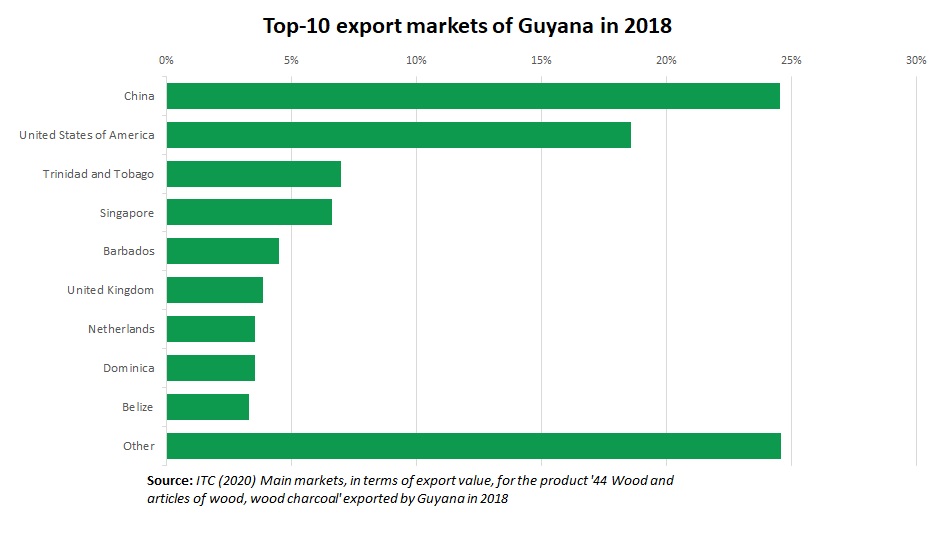Overview of timber sector of Guyana
Production and processing
Main harvested species
The forests of Guyana contain more than 1000 tree species; according to ITTO (2019) the main species exported over 2015-17 were, in descending order:
- Wamara (Brown Ebony, Ironwood) (Swartzia leiocalycina) – logs and lumber
- Purpleheart (Guarabu, Amarante, Purperhart) (Peltogyne venosa) - logs and lumber
- Greenheart (Demerara greenheart) (Chlorocardium rodiei) – logs and lumber
- Shibadan (Araracanga, Bois macaye, Kromantl Kopi) (Aspidosperma album) – logs and lumber
- Mora (Pracuuba) (Mora excelsa) – logs and lumberKabukalli (Cupiúba, Goupie, Kopi) (Goupia glabra) – logs and lumber
- Darina (Angelim, Makka Kabbes) (Hymenolobium flavum) – logs and lumber
- Tatabu (Sucupira, Saint Martin gris, Zwarte Kabbes) (Diplotropis purpurea) – logs and lumber
- Tonka Bean (Cumaru, Tonka) (Dipteryx odorata) – logs and lumber
- Wamaradan (Angelique, Basralokus) (Dicorynia guianensis) – logs and lumber
- Wallaba (Wapa, Bijlhout) (Eperua falcata & E. grandiflora)– poles and posts-
The Guyana Forestry Commission (2019) reports the following main exported species for 2019, in descending order: Wamara, Greenheart, Kabukalli, Wallaba, Purpleheart, Shibadan, Crabwood (Andiroba, krappa)(Carapa procera & C. guianensis), Mora and Tonka Bean.
In addition to these species there are other species which are of interest in the international market, such as:
- Bulletwood (Massaranduba, bolletrie) (Manilkara bidentata), although harvesting of this species is allowed by special permission only.
- Locust, (Jatoba, rode lokus) (Hymenaea courbaril), although for the export of this species special regulations apply.
- Washiba (Ipé, groenhart) (Tabebuia serratifolia (new name: Handroanthus serratifolius)
According to ITTO (2019), Guyana produced on average approximately 549,000 m3 of primary timber products between 2014 and 2018, which almost entirely originated from national forests. The country's timber exports are primarily based on the export of logs and to a smaller extent on the export of sawn wood. The total export value of primary timber products was around 65.2 million US dollars for the period 2014-2018 according to ITTO (2019).
The GFC has discontinued submitting production and trade data to ITTO since before 2014 and data reported by ITTO are based on estimates by ITTO (ITTO, 2019). According to the GFC Forest Sector Information Reports for the period 2014-2018, average production over this period was approximately 406,000 m³ per annum. According to GFC (2015, 2016, 2017, 2018) the total value of log, sawnwood, roundwood, veneer and plywood exports averaged 40.4 million US dollars per annum. For details on volume see the table below. A slump in both production and export occurred since 2014; average production over the period 2016-2018 fell to 359,000 m³ and export to 112,000 m³. The export value decreased steadily from 51.5 million US dollars in 2014 to 33.3 million US dollars in 2018.
Timber harvesting is mainly carried out in the central and north-eastern parts of the country since a lack of ready access and long distances to the market currently make the commercial harvesting of the forests in the south economically infeasible.
Export
The forest industry of Guyana consists mainly of logging and sawmilling operations. Export of logs is a significant part of the industry’s exports, although the national log export policy aims to stimulate more value-added activities in Guyana; e.g. by charging a progressively increasing rate of export commission (currently max. 20%) on targeted species that have been reflecting high volumes of export in log form. A full ban on log exports has recently been proposed for a number of species (Purpleheart, Locust, Crabwood, Red Cedar, Washiba, Letterwood and Snakewood) in the National Log Export Policy for the period 2016 to 2020. As can be observed from the graph below Guyanese timber is exported to many regions of the world, although logs are mainly exported to China and India while sawn wood and other processed products are exported to a much wider range of destinations.1
1 According to the Guyana Forestry Commission, the USA formed 22% of the export market in value in 2019, followed by China with 18%, India with 7%, Trinidad & Tobago, Barbados, Netherlands all with 5%, New Zealand and Singapore with 4% and the UK with 3%.

Logistics infrastructure
There are several different modes of transporting timber and timber products to the main port of export in Georgetown. The two main modes are waterways and roads. However, the underdevelopment of the road infrastructure in the rural areas has caused timber exporters to rely on less expensive modes of transport including water transport. In a few cases, some operators have the benefits of roads built by mining concessions and Amerindian villages, but this is more the exception.


